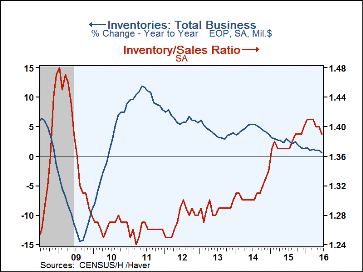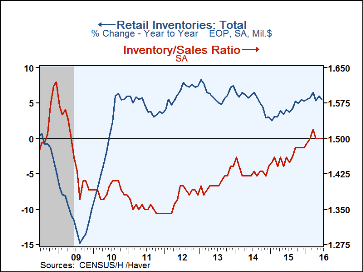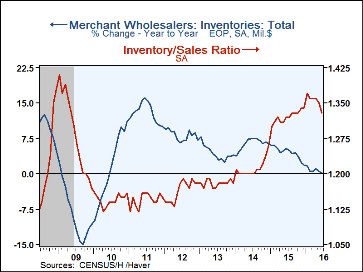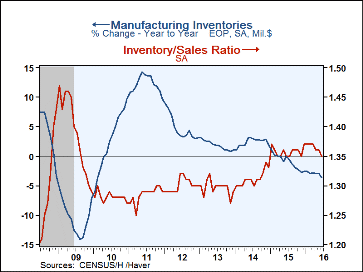 Global| Aug 12 2016
Global| Aug 12 2016Business Inventories Increase Slightly; Sales Jump
by:Tom Moeller
|in:Economy in Brief
Summary
Total business inventories edged 0.2% higher (0.5% y/y) during June following an unrevised 0.2% increase in May. Total business sales strengthened 1.2% (-0.6% y/y) after a 0.3% rise, revised from 0.2%. Retail inventories rose 0.5% [...]
Total business inventories edged 0.2% higher (0.5% y/y) during June following an unrevised 0.2% increase in May. Total business sales strengthened 1.2% (-0.6% y/y) after a 0.3% rise, revised from 0.2%.
Retail inventories rose 0.5% (5.5% y/y) for a second consecutive month. Inventories excluding motor vehicles and parts rose 0.2% m/m (2.9% y/y) after a 0.3% rise. Motor vehicle & parts inventories inventories increased 0.9% (10.9% y/y) and have been strengthening all year. Food & beverage store inventories increased 0.7% (3.1% y/y), but gains elsewhere in the retail sector have been declining or minimal. Merchant wholesale inventories increased 0.3%, as reported earlier this weak, and factory sector inventories eased 0.1%, also as reported earlier.
Total business sales jumped 1.2%, but remained down 0.6% y/y. Sales were strong across sectors. Wholesale sector sales strengthened 1.9% (-0.4% y/y) after two firm monthly increases. Retail sales increased 0.9% (2.6% y/y), as already reported. Sales excluding autos jumped 1.0% (2.9% y/y) on the strength of building material sales. Factory sector shipments improved 0.7%, but they were down 3.5% y/y.
The inventory to sales ratio eased to 1.39, its lowest level since November. The retail sector ratio held steady at 1.50. The I/S ratio excluding autos, however, declined to 1.27, its lowest level since August. Inventory control in the durable goods sector, outside of autos, has been notable. The I/S ratio in the soft goods area, however, has been rising. Merchant wholesalers have been lowering their I/S ratio, as have manufacturers.
The manufacturing and trade data are in Haver's USECON database.
| Manufacturing & Trade | Jun | May | Apr | Jun Y/Y | 2015 | 2014 | 2013 |
|---|---|---|---|---|---|---|---|
| Business Inventories (% chg) | 0.2 | 0.2 | 0.1 | 0.5 | 1.3 | 3.7 | 3.9 |
| Retail | 0.5 | 0.5 | -0.1 | 5.5 | 5.3 | 3.1 | 7.4 |
| Retail excl. Motor Vehicles | 0.2 | 0.3 | -0.2 | 2.9 | 4.1 | 2.6 | 4.8 |
| Merchant Wholesalers | 0.3 | 0.2 | 0.7 | 0.2 | 1.9 | 6.5 | 4.0 |
| Manufacturing | -0.1 | -0.1 | -0.1 | -3.7 | -2.6 | 1.8 | 1.0 |
| Business Sales (% chg) | |||||||
| Total | 1.2 | 0.3 | 0.8 | -0.6 | -2.6 | 2.8 | 2.9 |
| Retail | 0.9 | 0.1 | 1.4 | 2.6 | 1.6 | 3.9 | 3.8 |
| Retail excl. Motor Vehicles | 1.0 | 0.2 | 1.0 | 2.9 | 0.2 | 3.2 | 2.6 |
| Merchant Wholesalers | 1.9 | 0.7 | 0.8 | -0.4 | -4.3 | 3.6 | 3.1 |
| Manufacturing | 0.7 | 0.1 | 0.4 | -3.5 | -4.4 | 1.2 | 2.1 |
| I/S Ratio | |||||||
| Total | 1.39 | 1.40 | 1.40 | 1.37 | 1.38 | 1.31 | 1.29 |
| Retail | 1.50 | 1.50 | 1.50 | 1.46 | 1.46 | 1.43 | 1.41 |
| Retail excl. Motor Vehicles | 1.27 | 1.28 | 1.28 | 1.27 | 1.27 | 1.24 | 1.23 |
| Merchant Wholesalers | 1.33 | 1.35 | 1.36 | 1.32 | 1.32 | 1.21 | 1.18 |
| Manufacturing | 1.35 | 1.36 | 1.36 | 1.35 | 1.36 | 1.31 | 1.30 |
Tom Moeller
AuthorMore in Author Profile »Prior to joining Haver Analytics in 2000, Mr. Moeller worked as the Economist at Chancellor Capital Management from 1985 to 1999. There, he developed comprehensive economic forecasts and interpreted economic data for equity and fixed income portfolio managers. Also at Chancellor, Mr. Moeller worked as an equity analyst and was responsible for researching and rating companies in the economically sensitive automobile and housing industries for investment in Chancellor’s equity portfolio. Prior to joining Chancellor, Mr. Moeller was an Economist at Citibank from 1979 to 1984. He also analyzed pricing behavior in the metals industry for the Council on Wage and Price Stability in Washington, D.C. In 1999, Mr. Moeller received the award for most accurate forecast from the Forecasters' Club of New York. From 1990 to 1992 he was President of the New York Association for Business Economists. Mr. Moeller earned an M.B.A. in Finance from Fordham University, where he graduated in 1987. He holds a Bachelor of Arts in Economics from George Washington University.










